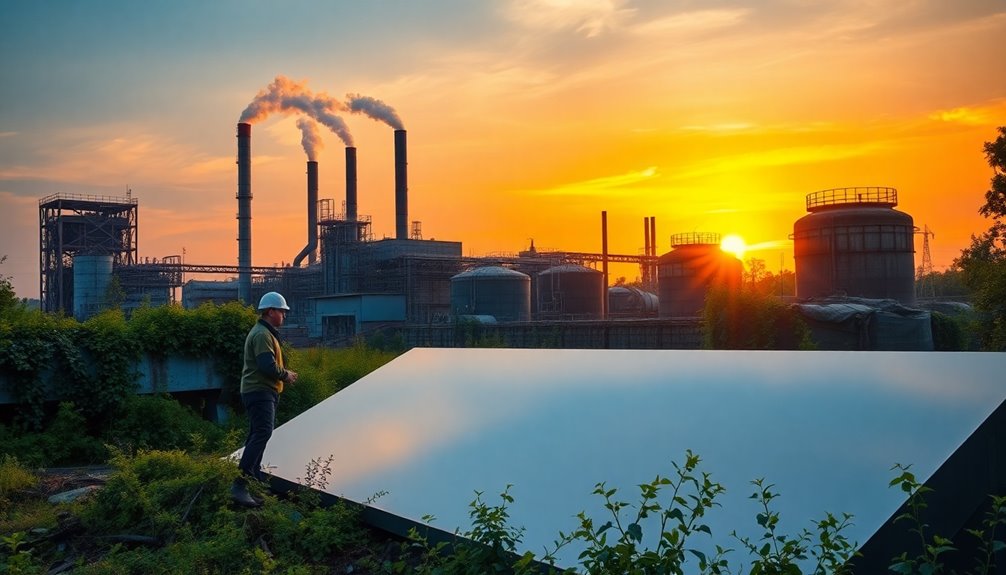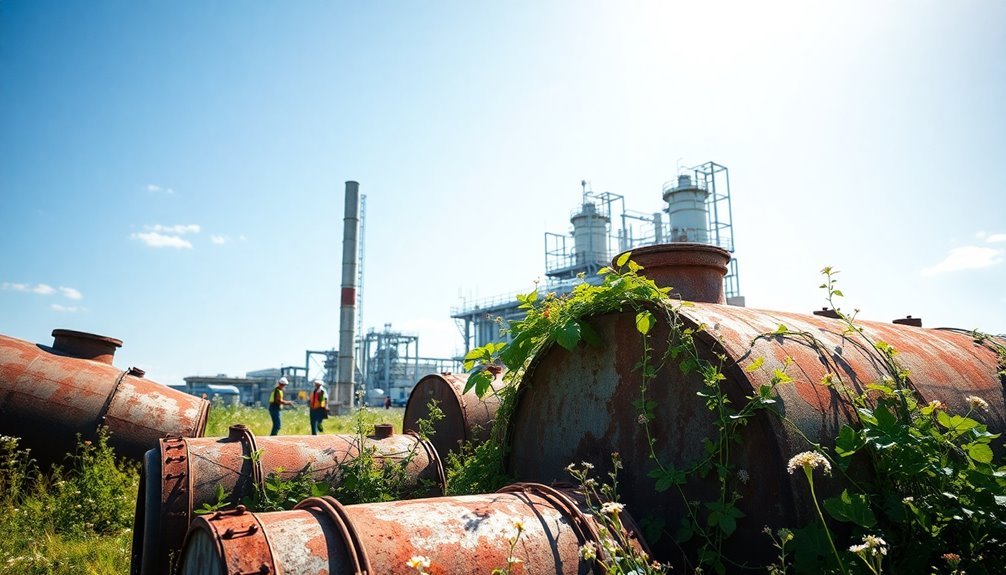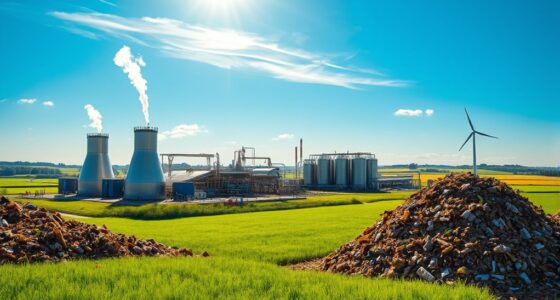Clean steel initiatives are vital for securing the EU's sustainable future. By investing in clean technologies, like hydrogen-based steelmaking and carbon capture, the EU aims to drastically reduce emissions and lessen reliance on fossil fuels from authoritarian regimes. This transition not only promotes environmental goals but also supports military readiness and strategic autonomy. As the EU moves forward, you'll discover more about the innovative strategies and investments shaping this clean steel revolution.
Key Takeaways
- Increased clean steel production in the EU can enhance military readiness by reducing dependence on fossil fuels from authoritarian regimes.
- The EU aims for substantial CO2 emissions reductions, aligning clean steel initiatives with broader environmental policy goals.
- Investment in green hydrogen and innovative technologies is crucial for achieving near-zero emissions in steel production.
- The EU's Steel and Metals Action Plan supports competitiveness and sustainability, vital for securing the future of the steel sector.
- Advancing clean steel initiatives fosters climate resilience and contributes to strategic sovereignty within Europe.

As the European Union ramps up its clean steel initiatives, you're witnessing a pivotal shift in both industry and environmental policy. With the number of clean steel projects soaring from 23 in 2021 to 38 in 2023, it's clear that the EU is serious about decarbonization. Green hydrogen projects have doubled in the past two years, showcasing Europe's commitment to innovation in sustainable steel production.
Meanwhile, the UK lags behind, having only introduced one clean steel project using blue hydrogen. The EU aims to decarbonize 30% of primary steel production by 2030, targeting an impressive 80-95% reduction in CO2 emissions by 2050 compared to 1990 levels. Germany's €8.5 billion investment in decarbonizing its steel sector highlights the financial commitment needed to meet these ambitious goals. Notably, the UK steel industry contributes £2.4bn to the economy, emphasizing its importance to local economies and the need for effective transition strategies.
The focus on hydrogen-based steelmaking and carbon capture technologies is vital, as the region's steel production currently emits between 1.6 and 2.0 tonnes of CO2 per tonne of crude steel. You're also seeing how green steel technology, especially Direct Reduced Iron and Electric Arc Furnace processes, is gaining traction. These innovations attract significant investment and policy support, while the increasing use of recycled scrap and renewable energy sources like wind and solar is crucial for achieving near-zero emissions.
However, the steel sector faces challenges like high energy costs and the need for improved competitiveness. The emergence of green steel premium pricing offers a market incentive, but energy-intensive industries still require aid packages to combat rising costs. The EU's Steel and Metals Action Plan aims to ensure that clean steel production is commercially viable through regulatory initiatives and trade measures.
As geopolitical tensions rise, the push for green steel also supports military readiness and strategic sovereignty. By reducing reliance on fossil fuels from authoritarian regimes, you're witnessing a significant step toward climate resilience and a sustainable future in Europe's steel industry.
Frequently Asked Questions
What Are the Environmental Benefits of Clean Steel Production?
Clean steel production offers significant environmental benefits.
You'll find that steel is 100% recyclable, which reduces landfill waste and conserves raw materials. By using electric arc furnaces, it lowers carbon emissions compared to traditional methods.
Additionally, modern processes utilize renewable energy, further minimizing greenhouse gases. The durability of steel structures means less frequent replacements, conserving resources and reducing environmental impacts.
How Does Clean Steel Impact Job Creation in the EU?
How can clean steel impact job creation in the EU?
By investing in green technologies and transitioning to sustainable production methods, you're not just reducing emissions—you're also opening doors to new employment opportunities.
The shift away from coal-based production to hydrogen technologies can revitalize the industry, potentially generating thousands of jobs.
As the sector evolves, you'll witness the emergence of roles tied to clean energy and recycling, securing a brighter future for workers.
What Technologies Are Used in Clean Steel Manufacturing?
In clean steel manufacturing, you'll find several innovative technologies at play.
Molten Oxide Electrolysis (MOE) uses renewable electricity to create high-purity molten iron without carbon emissions.
Electric Arc Furnaces (EAFs) recycle scrap steel, cutting down carbon intensity.
Direct Iron Electrolysis extracts iron from ore using carbon-free electricity.
Additionally, low-carbon hydrogen and Carbon Capture, Utilization, and Storage (CCUS) further enhance sustainability by reducing emissions in traditional processes.
These methods pave the way for greener steel production.
How Does Clean Steel Contribute to the Eu's Climate Goals?
Clean steel's crucial contribution to the EU's climate goals can't be overstated.
By dramatically decreasing emissions, it delivers a double dose of sustainability and supports a shift towards a greener grid.
You'll witness a world where innovative industries thrive, powered by renewable energy.
As you embrace cleaner technologies, you'll help secure jobs and bolster the economy, ensuring a balanced blend of environmental and industrial interests while paving the path for a low-carbon future.
What Are the Economic Implications of Transitioning to Clean Steel?
Transitioning to clean steel has significant economic implications for you and the industry.
It can create over 30,000 jobs annually in the U.S., boosting local economies. As demand for clean steel grows, capturing a larger market share could generate up to $5.4 trillion by 2050.
Lower hydrogen production costs and federal tax incentives will help make green steel more competitive, ultimately supporting sustainable practices and enhancing your industry's resilience in a changing market.
Conclusion
As you stroll through a bustling European city, the gleam of clean steel structures catches your eye, symbolizing a sustainable future. It's a reminder that embracing innovation can lead us away from outdated practices, like heavy tanks of the past. By prioritizing clean steel, the EU isn't just forging a new industry; it's crafting a brighter, more resilient path forward. Coincidentally, you realize that each step you take on these vibrant streets echoes the promise of a cleaner tomorrow.









